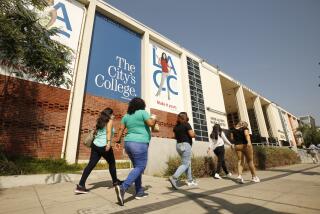Junior Colleges : Builder of Empire Sees Its Decline
- Share via
For 14 years, Leslie Koltai has headed what he and others have proudly referred to as the “world’s largest community college district.”
Throughout the 1970s, enrollments in the nine colleges of the Los Angeles Community College District rose steadily and an influx of new students--mid-career adults, the elderly and housewives returning to the job market--seemed to promise continuing growth.
Koltai, as the district chancellor, supervised the building of new campuses, theaters and libraries.
“I built more libraries than anyone in the community colleges in the nation, than anywhere,” he said in an interview last week.
Overseas Operation
The Los Angeles district even expanded overseas. Its “Metropolitan College” once enrolled 36,000 military personnel and their families at locations around the world. Koltai also created what he called the “10th Dimension,” a college that would serve “non-traditional students” such as jail inmates and offer courses via television and the telephone.
But in recent years, the empire has been shrinking, and Koltai--the planner, the builder and the big thinker--has become a budget cutter who talks of shrinking the community colleges and “narrowing their scope.”
It has not been an easy transition. As enrollments have dwindled--from a high of 139,000 in 1982 to 87,000 now--Koltai has been forced to recommend round after round of reductions. Classes have been canceled, custodians and clerical workers have been laid off and everything from computers to toilets has gone unrepaired. Today, the board will vote on the toughest cutback yet--a plan to lay off 142 tenured professors.
“All statistical projections for the future are wrong,” Koltai insisted last week in a sarcastic reflection on the sudden downturn in the district’s fortunes.
Likened to Kissinger
Among some who know him, Koltai, 54, a Hungarian refugee who came to the United States after the 1956 revolt, is referred to as “Dr. K.” Heavyset, with thick glasses and a thick accent, he bears a strong resemblance to the better known Dr. Henry Kissinger.
And comments on Koltai from staff members, district trustees, faculty and students, closely parallel the assessments of the former secretary of state.
His admirers say he is brilliant, shrewd and a visionary thinker who is five steps ahead of his competitors.
His critics portray him as arrogant, manipulative and ruthless.
In recent months, as the district’s financial picture has grown bleaker, the criticism has grown louder.
“To put it bluntly, he is manipulative and duplicitous,” said Les Boston, an English instructor at Valley College in Van Nuys and one of Koltai’s many faculty critics. “He rewards those who are loyal to him and punishes anyone who disagrees.”
Faculty members, irked in recent years by Koltai’s selection of union officials for top management jobs, suggest that he has co-opted his most effective antagonists.
In 1983, he appointed Virginia Mulrooney, the fiery president of the faculty union, as the vice chancellor for personnel services, at $78,700 a year. Earlier, he had picked union activists Cedric Sampson as a special assistant and Art Avila as president of East Los Angeles College.
Henry Cobos, a music instructor at East Los Angeles College, complains that Koltai has set up a “highly concentrated administration” housed in a plush downtown office building that is “totally isolated” from the campuses.
Susan Dudasik, a Valley College student, said she realized just how centralized the administration was when she suggested to Valley officials last week that they lower the flags in honor of the Challenger astronauts.
“They said they’d have to call downtown first to see if it was OK,” she said.
In November, about 150 instructors and students journeyed downtown to demonstrate against the budget cuts and to urge the trustees--in speeches and in protest signs--to “Dump Koltai.”
Not all of the faculty and students, however, are upset with Koltai.
“At times your job must seem thankless,” wrote Michael Cornner, a Pierce College arts instructor after Koltai visited that campus, adding that most instructors did not agree with the attacks on him “leveled by crank members of the faculty.”
Nevertheless, the district’s headquarters--seven floors of an office building at 619 7th St.--has become a symbol of the faculty’s frustration.
Though Koltai and the trustees say they want to move out of the building to save money, the district is locked into a lease that doesn’t expire until 1988. The rent comes to $920,000 this year. The total cost for “general administrative expenses,” according to budget officials, is $5 million this year, 2.5% of the overall district budget.
Koltai is also derided for what are viewed as extravagant expenses for a fiscally strapped district. Besides his salary of $104,000, he gets a $5,400-a-year car allowance and uses a $4,500 car phone. His contract also gives him 37 days of vacation per year for which he gets paid if he doesn’t take the time off.
Outside Los Angeles and away from discussions of the district’s troubles, however, Koltai is praised as a perceptive and scholarly leader.
“He is one of the most thoughtful community college leaders not only in California but in the nation. He has an amazing grasp of where we ought to be going,” said Gerald Hayward, a consultant in Sacramento and former California community college chancellor. “He is also politically skillful. You’d have to be skillful to survive as long as he has with such a politically volatile board.”
Indeed, the Board of Trustees of the Los Angeles Community College District has been a springboard for a host of local politicians, including former Gov. Edmund G. Brown Jr., county Supervisor Mike Antonovich, Dist. Atty. Ira Reiner and Assemblywomen Gwen Moore (D-Los Angeles) and Marian LaFollette (R-Northridge).
“It’s not easy to make education policy if you have board members mostly concerned with furthering their political ambitions,” said Richard Moore, president of Santa Monica City College. “I admire anyone who’s been able to handle that hot seat and hold that system together over so many years.”
Student Fees
Koltai’s main problem, consultant Hayward said, has been trying to cut back fast enough to match “the catastrophic enrollment decline” that followed the state’s imposition of a $50-per-semester student fee.
Last June, one day after two board members ran and won in citywide elections, district officials announced that they would need a $5-million advance to finish the fiscal year.
That embarrassment, which later prompted investigations by the state’s Little Hoover Commission and an audit by a Los Angeles County Grand Jury, seemed to prompt a new attitude on the Board of Trustees.
In September, the board, at Koltai’s recommendation, reduced the budget by $8 million to pay off the advance and to balance the budget for the current school year. In December, with enrollments still lower, the board voted to charge employees a $40-a-year parking fee and to furlough all administrators for two weeks in the spring.
The board members, in closed session, have apparently united behind Koltai’s recommendation for the latest cutbacks, the layoff of the 142 tenured professors.
“Les and I made a mutual commitment to transcend our problems from the past and to turn things around,” said Monroe Richman, new board president who was once Koltai’s sharpest critic on the board. “We’ve worked well together and I think we’re making progress.
“As an educator, he is superb,” Richman commented, “but as a chief fiscal officer, he leaves something to be desired, and I’ve told him that.”
But Richman was quick to add: “If we have problems, the board is certainly not blameless. He made a recommendation a number of years ago to issue (layoff notices to instructors) and we wouldn’t go along with him.”
For his part, Koltai said the problems facing community colleges “are a national crisis. It’s the conflict between mass education and quality.”
Koltai became chancellor in 1972, just three years after the Los Angeles junior colleges were split off from the Los Angeles Unified School District.
His first job after immigrating had been as professor of Slavic languages at Pasadena City College. In 1962, he became chairman of the foreign languages department there, and after earning a doctorate in education at UCLA in 1967, he was named chancellor of the Kansas City Metropolitan Community Colleges.
Over the years, he said, he has advocated a more structured academic program with entrance tests and a clear curriculum and put an emphasis on students transferring to four-year universities.
This was not the fashionable view in community college circles in the 1970s. “I was not one of the boys,” Koltai said.
It also was not a philosophy strictly followed in the Los Angeles colleges, as Koltai admits, since the two-year schools offered their share of “marginal courses.”
Something for Everybody
“We had something for everybody, from macrame to nuclear medicine,” he said, a curriculum proliferation encouraged by a state financing that paid colleges based on the number of students who signed up for any course, regardless of its merits.
Nevertheless, Koltai said he “emphasized quality courses and libraries” and added that he is pleased that the tide appears to be flowing in his direction.
“Some people (in community colleges) think we just need to expose students to college. Let them drive up . . . and drive away again, without ever getting near a library,” he said. “They are happy if a student signs up for an auto mechanics course and drops out after he learns to repair the carburetor. They say we have fulfilled a need.”
At his urging, several Los Angeles colleges began requiring placement tests for new students, “which I’ve paid a tremendous price for. That’s one reason we’ve lost so many students.”
Koltai said he believes that the emphasis on quality courses and a structured curriculum will help turn around the perception of the colleges and, eventually, their enrollments.
Criticism From Campuses
Koltai bristles at much of the criticism coming from the campuses, suggesting that some administrators are blaming him for problems they should solve on their own.
“I work out the major problems, but they never see that,” he said, pointing out that in recent weeks he negotiated an agreement with Santa Monica City College to exchange some students with West Los Angeles College. He also persuaded the state Board of Governors to recommend the construction of a permanent building at Mission College in the north San Fernando Valley.
Koltai also regularly visits the nine campuses, to investigate problems or meet with faculty and students.
“I go out there and let them shoot at me,” he said, adding that he believes most faculty members support him despite the move to lay off instructors in under-enrolled classes.
The shrinking enrollment requires a layoff of instructors, he said. “Last semester, we had 3,200 classes with less than nine students. That’s out of 12,000 classes in all,” he said.
But he expects harsh protests at this week’s board meeting.
“It will be ‘Beat Up Koltai Day,’ ” he said. “They will also try to recall the board members,” although he predicted that the district would enact the layoffs despite the opposition.
Over the last year, Koltai said, he has thought more than once of resigning, but decided against it.
“I want to see this district through the bad periods as well as the good ones,” he said. “I want to be here to turn things around.”
More to Read
Sign up for Essential California
The most important California stories and recommendations in your inbox every morning.
You may occasionally receive promotional content from the Los Angeles Times.











